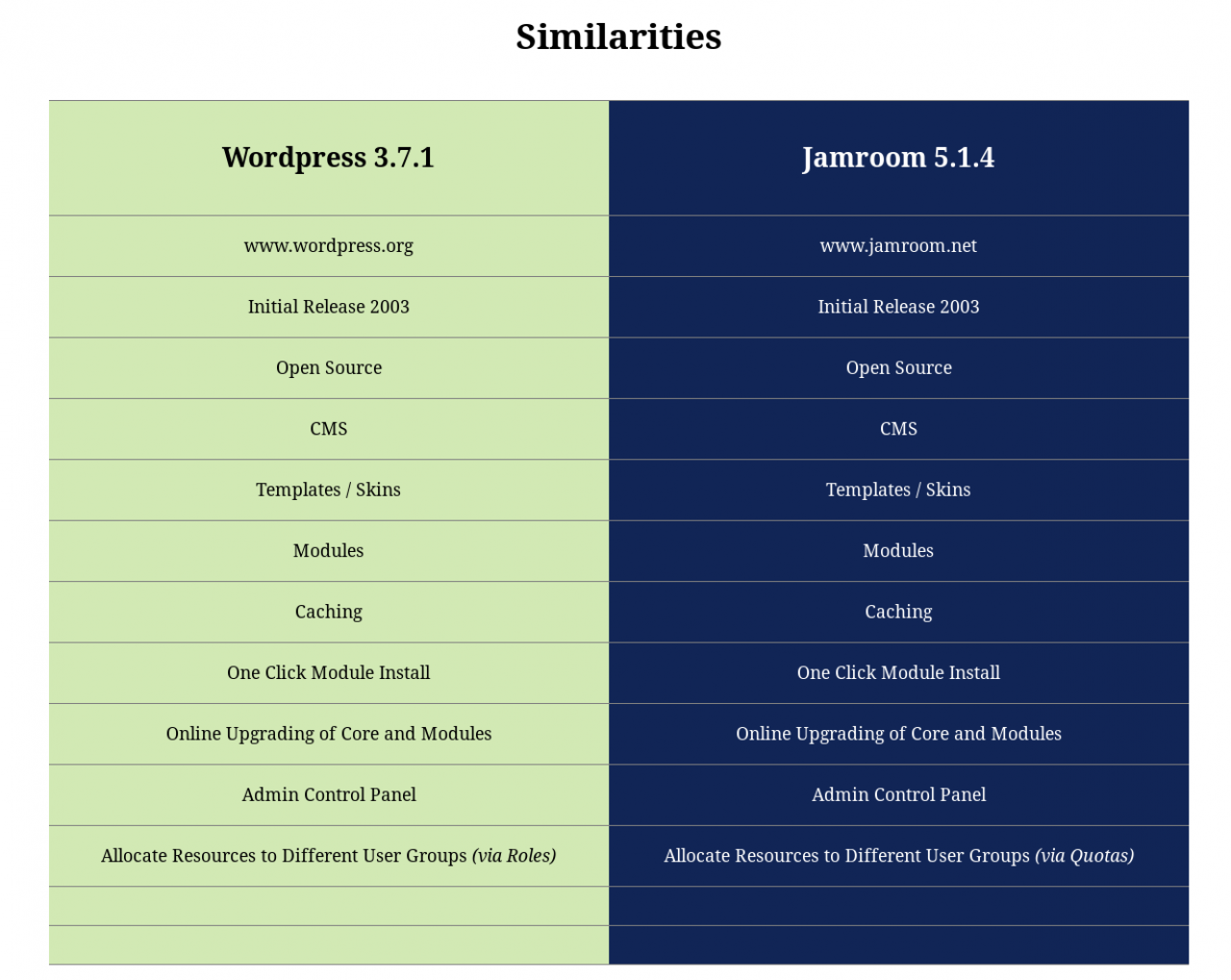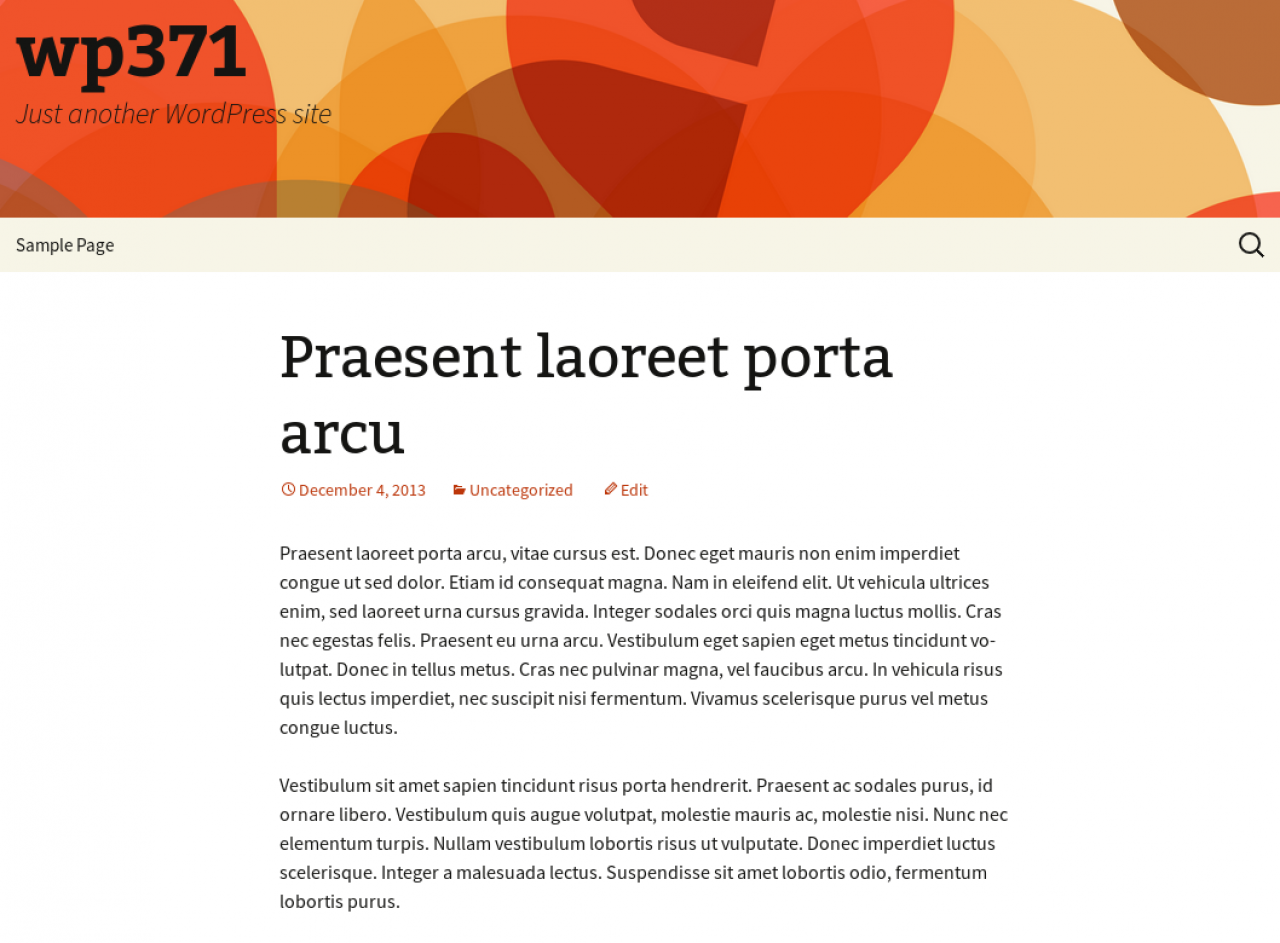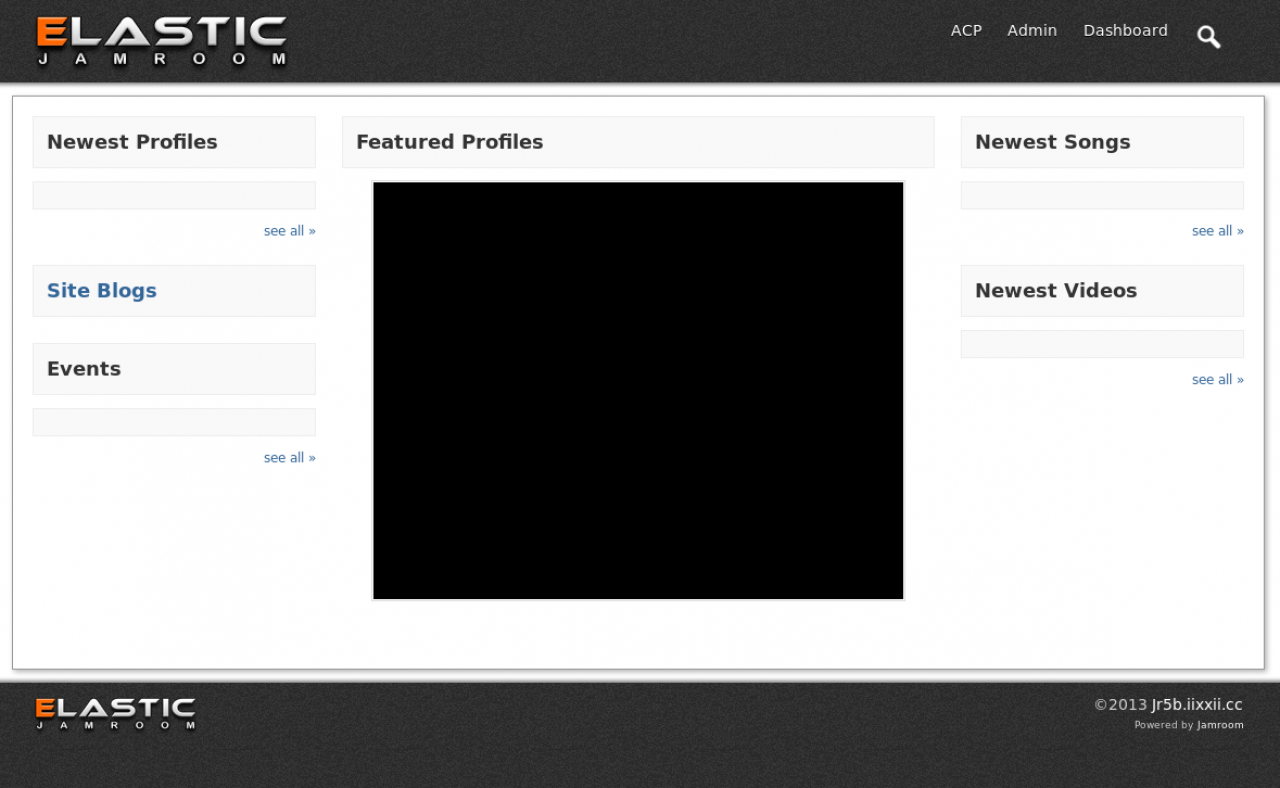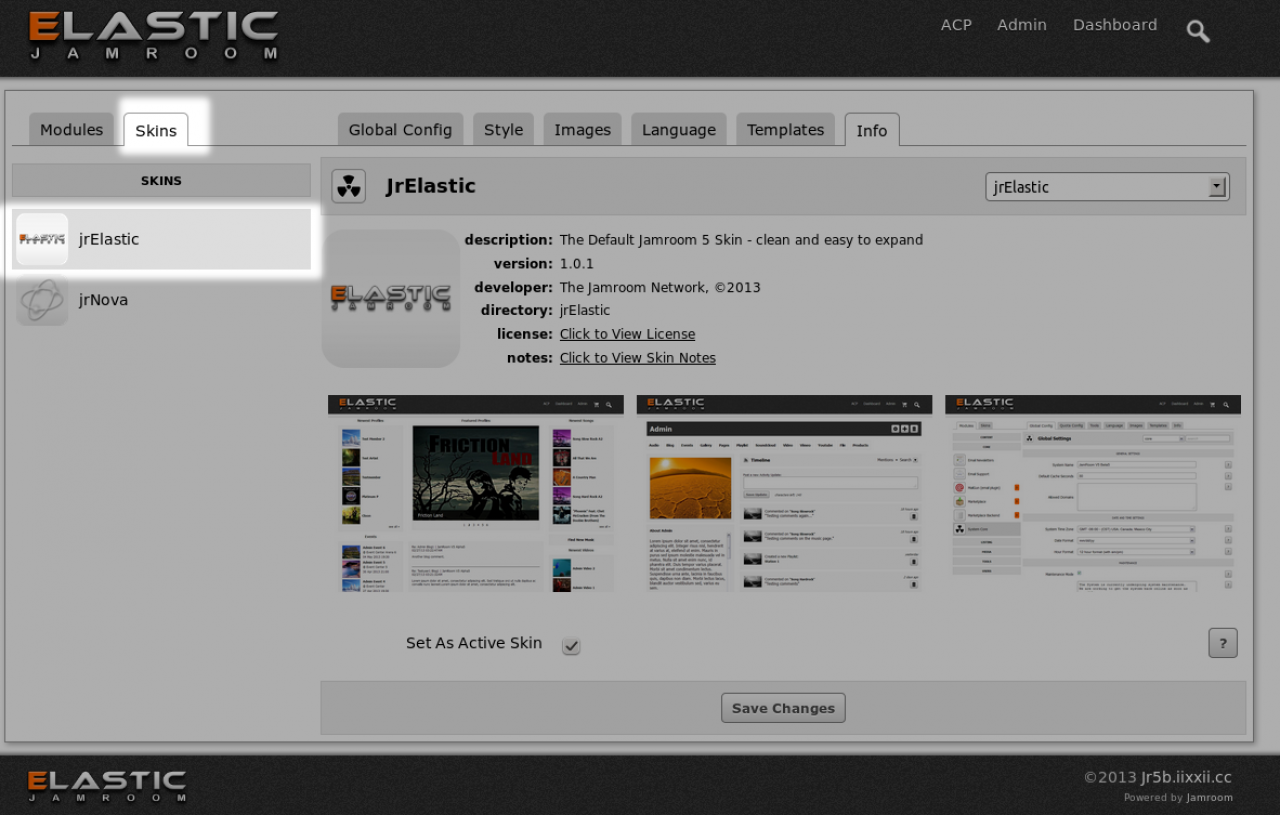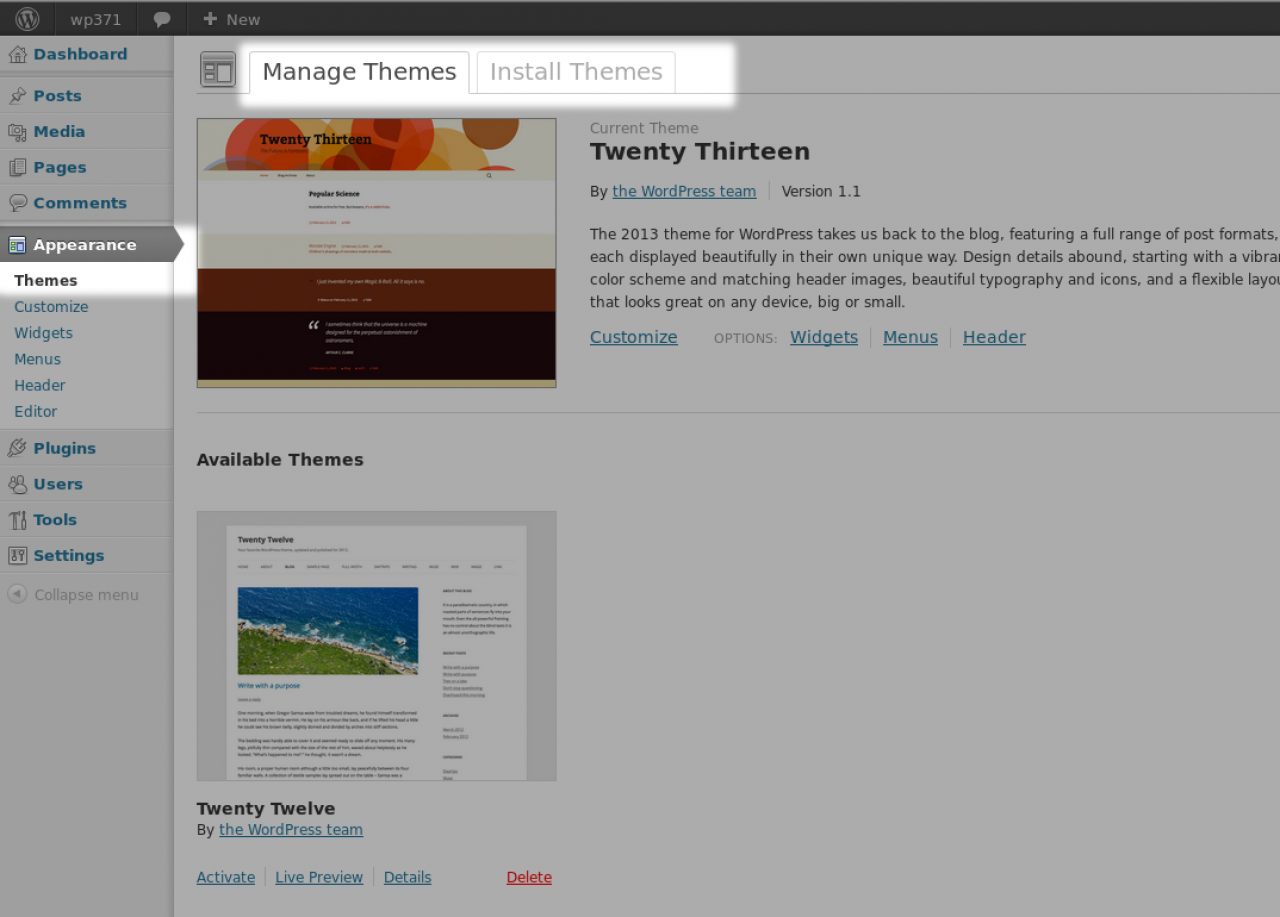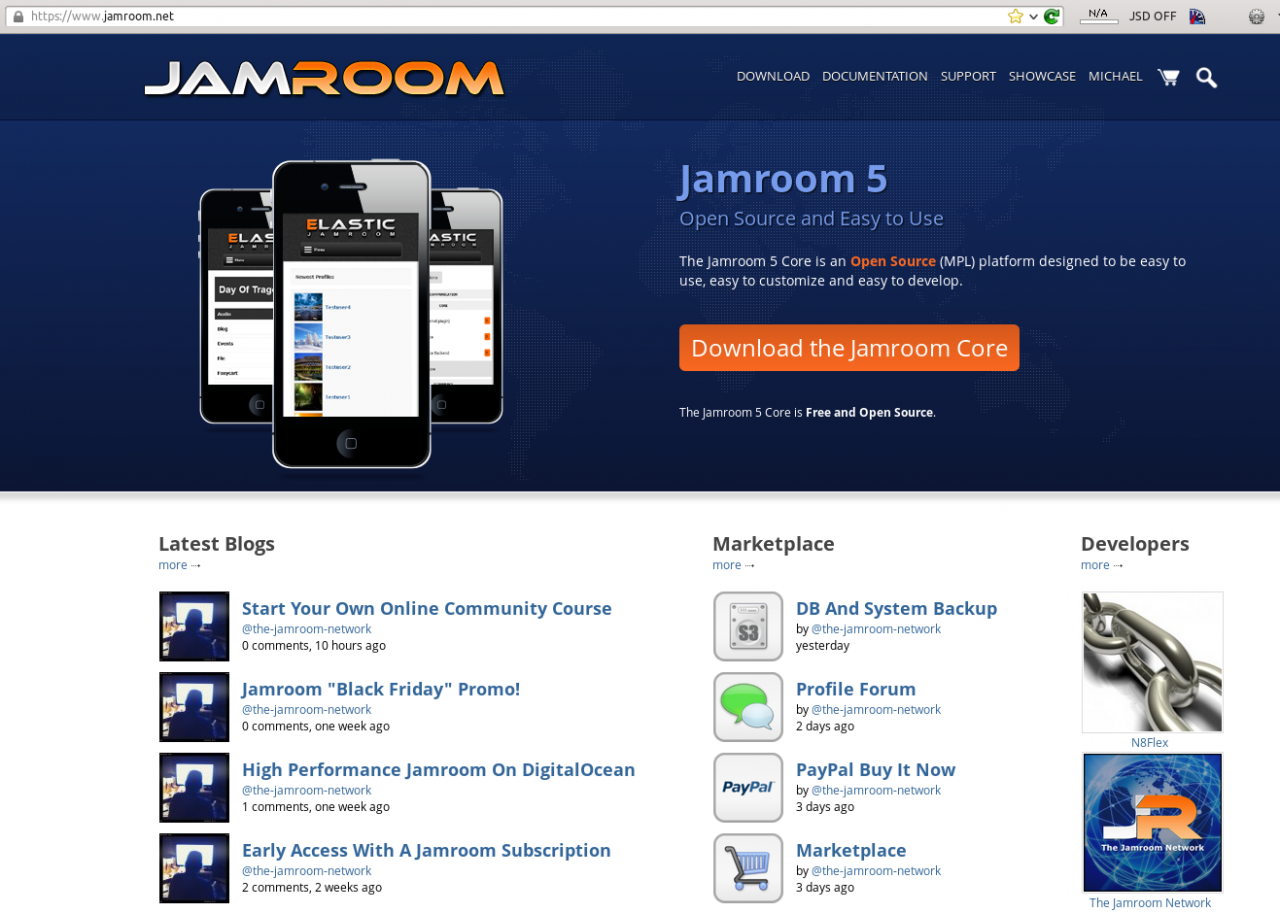Jamroom vs Wordpress
-
 Video outlining some of the differences and simailarities between Jamroom and Wordpress
Video outlining some of the differences and simailarities between Jamroom and Wordpress -
Right, so what were going to look at now is a few of the similarities between Wordpress and Jamroom. The current Wordpress version is 3.7.1 and the current Jamroom version is 5.1.4. This December 2013 so we're looking at going into 2014 what are we looking at here.
Transcription
-
Wordpress: www.wordpress.org
Jamroom: www.jamroom.net
Both were released back in 2003 but Wordpress was initially released under the open source GPL license, while Jamroom's been proprietary up until 2012 when version 5 began development.
Looking at similarities:
* they are both open source
* they both have themes/templates/skins that allow you to change the appearance of them.
* they both have modules to extend the capabilities of the initial system that you start with.
* they both have caching to allow for lightening the load on your server.
* they both have one-click module install.
Once you have installed the main system you can go into the admin control panel and have a look through different modules that are available for the system.
If you find one you like you can click on it and the module will automatically be downloaded and installed in the system.
Either system can do that.
When new versions of Wordpress come out, you will be alerted in the control panel and you can click on it and it will automatically be downloaded and upgraded.
Same thing with Jamroom, exactly the same system. When a new version comes out you can click the button and it updates it.
They both have an admin control panel. -
and a way to allocate different resources to different groups.
Different names for them though. Wordpress calls them Roles. Coming from the thinking of a blog website: 'Editors', 'Administrators' etc..
Jamroom calls them Quotas. Different quotas of resources that are available to the user.
But both systems allow the allocation of resources that the system has to be divided up between different users.
-
The differences between Jamroom and Wordpress are going to make you want to choose either one or the other.
Differences
If both systems were exactly the same there would be no reason for both to exist, one would be fine.
There would be no reason to have Jamroom if Wordpress was exactly the same as it.
So the differences are going to be more important things to look at when making a decision between; do you want to install Wordpress or do you want to install Jamroom.
One thing that stands out in Jamroom's favour is that Jamroom is running its own software system when you go to the site.
So when you go to jamroom.net and visit Jamroom, you can automatically see what type of system it is. Because, to point it out right now, Jamroom is community focused. Where as Wordpress is traditionally blog focused.
Its unfair to say that Wordpress is a blogging system because as soon as you start installing modules into it it expands and you can turn it into whatever you want.
Both have a base of php so really its a blank sheet and you could extend either in any direction you wanted to if you built the correct modules for it.
In Wordpress's favour its got a whole lot of modules out there, that you can click and install.
So you can really turn it into whatever you want it to be.
The starting base is Jamroom is a profile centric content management system.
-
Wordpress will use the content as the top level citizen of the site. So when content is created its created for the site. It can be created by any one of the users, but generally it seams to hold a top level position.
Eg: yoursite.com/the-content-comes-in-here
Where you can have different 'Contributors' putting that content into the site via the allocation of different Roles. So if they are a 'Contributor', they are able to write a piece of content that will come out on the main site.
The content is held to be a piece of content on its own, then Wordpress will present that content in different ways on the site.
The clear difference between that and Jamroom is that when a piece of content is created by a user, that piece of content belongs to the user. So although there will be lists and even content presented directly on the site itself, the core location for any piece of content is on the users profile.
-
The clear difference between that and Jamroom is that when a piece of content is created by a user, that piece of content belongs to the user. So although there will be lists and even content presented directly on the site itself, the core location for any piece of content is on the users profile.
-
So if there is Pages, or Youtube videos or Music, it will generally point back to whoever created that piece of content.
It's that concept of "Profile focused" vs "Content focused".
Are the contributors 'contributing content to the site' (Wordpress)
Or are the contributors 'uploading content to THEIR profile' and then that content distributed out across the site.
Probably stems from the root of what they were both designed for. Wordpress started life as a blogging system whereas Jamroom started life as a band system.
So the concept has remained, a band wants to have all of their songs on their profile, all of their events on their profile, everything to do with their band on their profile. And then they want their band to get exposure through the top level of the site. -
Theme designers
Both Jamroom and Wordpress can have the way the content is presented changed.
If the admin user decides to change the skin, (or the 'theme' in Wordpress's vocabulary), the output, what it looks like on the site will change.
In Jamroom's case: -
And in Wordpress's case:
-
You can select the theme/skins for either system.
If you wanted more, you can go searching through the system until you find a skin you like and install that.
Either system has auto install of skins which will be directly downloaded and installed.
The difference between Jamroom's and Wordpress's systems:
* Wordpress calls them 'themes'
* Jamroom calls them 'skins'
* Wordpress's theme files are written in php.
* Jamroom's skin files are written in smarty.net's templating language Smarty3
You can create whatever you want to in both of them.
I think that one of the core differences in ease of use is that Wordpress themes seam to have sections where you can just drag-n-drop what they call widgets into spaces that are left there for you by the theme designer. Its a really nice system.
If you want to add new things to the theme, the theme will give you certain areas where you can drag-n-drop widgets. Each theme will have different areas. In as far as usability goes, Wordpress themes are very easy to use. Especially if you don't have any HTML knowledge or don't like looking at code. Wordpress is excellent. -
Jamroom's not as advanced as drag-n-drop skins, however the flip side of that is that Jamroom Skin Designers get a whole lot of power.
Almost as much as module developers in deciding what features are available to the site.
Changing a Jamroom skin will change more than just the layout, the features that are available will change. The entire concept of the site will change with the change of a skin.
Ok, so that's a bit of a breakdown between the differences of Wordpress and Jamroom. Deciding which CMS is best for you will basically come down to which system is most familiar to you, and what kind of site you want to end up with when development is finished.
So one of the main things to keep in mind is Jamroom is very Profile Centric and adding modules will add features to the users profiles.
The more modules you add the more options your users have on their profile. And basically all content is stored on the users profiles, then aggregated out to the main site.
Profiles don't tend to change much when you change the skins, but the front end of a Jamroom site changes considerably by changing a skin.
That was Wordpress 3.7.1 vs Jamroom 5.1.4 compared.
-
As a final sign off, we will take a look at a Jamroom community website in action:
Sign off
http://www.jamroom.net
-
Jamroom.net is powered by Jamroom 5.
You can see that on the front page of the site, there is the 'Latest Blogs', the 'Marketplace', the latest 'Developers'. Which are all lists of content that exists on users profiles.
In the Downloads section of the site, modules available on the users profiles are made available to the top end of the site. Clicking on these modules will take you to the users profiles.
The community is "A community for people who run Jamroom CMS." and that is what you should be thinking when you're thinking Jamroom.
* "Building a community for someone."
* "Who is it being built for?"
* "What do those people need to do?"
On Jamroom.net its a "Developers and Users Community".
If we go to one of the users profiles, eg: https://www.jamroom.net/the-jamroom-network you will see a users profile. In the case of "The Jamroom Network" you will see that even the core development team is running as a standard developer in the community.
So they're no different to any other developer on the system. Developers have 'Blogs', 'Documentation', 'Forum', 'Payments', 'Bundles' etc....
With something like the 'Forum' module, that puts a forum onto the profile of the users, so each member in the developer quota has their own forum where users of their stuff can ask questions and chat.
There are other developers in the system, eg: https://www.jamroom.net/n8flex and if you go to his profile you will see that he too has the same options: 'Blogs', 'Documentation', 'Forum', 'Payments', 'Bundles' etc....
The forum posts in n8flex's profile are separate to all other developers. The 'Marketplace' tab on n8flex's profile show n8flex's marketplace offerings.
N8flex has the same priority as 'the-jamroom-network' in our community.
We are a community of developers.
So come and check it out.


